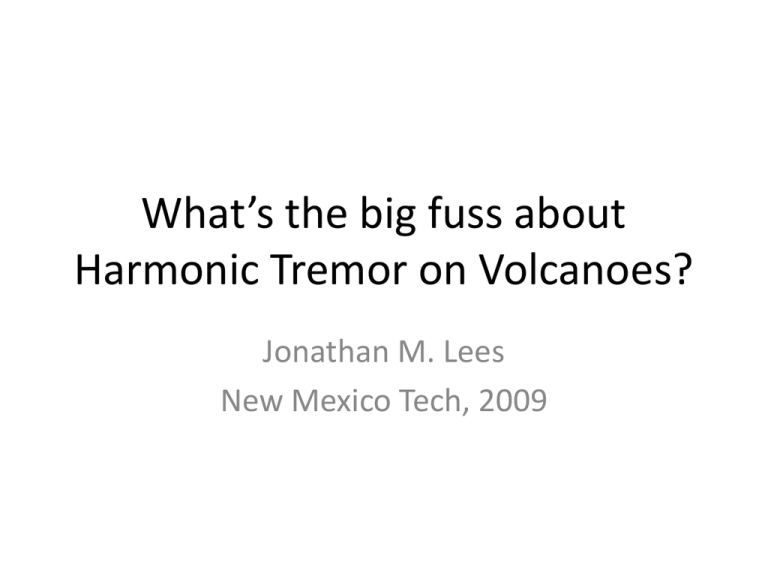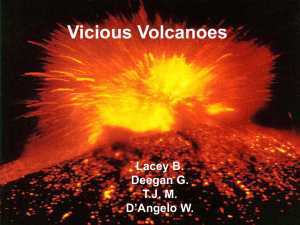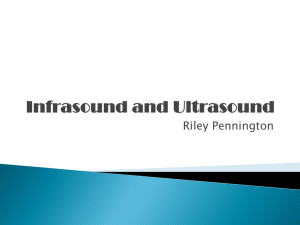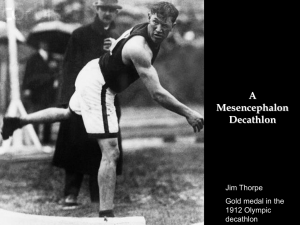Harmonic_Tremor
advertisement

What’s the big fuss about Harmonic Tremor on Volcanoes? Jonathan M. Lees New Mexico Tech, 2009 Where is it observed? Karymsky, Kamchatka Arenal, Costa Rica Sangay, Ecuador Reventador, Ecuador Tungurahua, Ecuador *Santiaguito, Guatemala (Semeru, Merapi…others?) Typical VT event at Mt. Merapi, Indonesia a) typical example of a VT-B type event recorded during a high activity phase at Mt. Merapi. Note that the overall frequency content is mainly between 1 — 10 Hz with a dominant frequency at roughly 3 Hz. b) zoomed out version of the same event in its three components. Whereas the P-wave arrival is clearly visible, no clear S-wave arrival can be seen. The circle marks the wavelet that has the approximate S-wave travel time for the estimated source location http://www.seismo.com/msop/nmsop/13 volcano/volcano2/volcano2.html Low Frequency Events a) example of a LF-wave group recorded at Mt. Merapi. Clearly the dominant frequency is around 1 Hz. b) shows an example of a LF event recorded at two different sites located at Redoubt volcano, Alaska (courtesy of S. McNutt, Alaska Volcano Observatory; AVO). The spindle shaped signal is also known as Tornillo. Harmonic tremor signal recorded at Mt. Semeru, Indonesia. Up to six overtones can be recognized starting with a fundamental mode located at roughly 0.8 Hz. Typical Karymsky Chugging Event, 1997 Initial explosion Chugging Acoustic Vertical North-South East-West Simple Harmonic Motion Sinusoid : 5 Hz (sample rate = 0.001) Sinusoids with 4 frequencies, 5,10, 15, 20 Ten harmonics, 5 through 50 Hz 10 Random Frequencies 10 frequencies around the harmonics randomly perturbed 10 frequencies around harmonics with slight perturbation Harmonic Tremor • Common on Volcanoes • Provides Constraints for Conduits: • • • • Geometry Composition Density Visco-elastic parameters Many researchers have contributed to the study of Harmonic Tremor • • • • • • • • K. Aki & M. Fehler B. Crosson B. Chouet B. Julian S. McNutt M. Ripepe V. Schlindwein M. Hellweg • • • • • • • • E. Gordeev T. Ohminato M. Garces M. Yamamoto H. Kumagai T. Nishimura R. Leet K. Konstantinou (review) In this presentation we are concerned with tremor that is accompanied by infrasonic emission Note Tremor on Seismic ? Reventador tremor Reventador tremor Reventador tremor Reventador tremor Seismo-Acoustic Tremor: Chugging • Observed when seismic and acoustic waves are discerned and correlated • Examples: – – – – – – – Arenal (Benoit & McNutt, 1997; Garces, 1998; Hagerty et al. 2000) Karmysky (Johnson & Lees, 1999; Lees et al. 2004) Sangay (Johnson & Lees, 1999; Lees & Ruiz, 2008) Reventador (Lees et al., 2008) Tungurahua (Ruiz et al., 2005) Fuego (Lyons et al.) Santiaguito (Lees et al.) Slow Fast Video Infrasound Chugging at Karymsky, 1997 While there are similarities between these chugging sequences, there is also considerable variability. Examples of Chugging at Sangay Volcano Chugging Spectrum Gliding Chugging Sound: Karymsky Infrasound, 1997 Fundamental Mode….and Harmonics? Karymsky Infrasound, 1997 Numerous episodes of seismo-acoustic tremor exhibit fundamental frequencies ranging between 0.7 to 1.4 Hz. 21 chugging events at Karymsky Karymsky, tremor (chugging) Santiaguito Explosion from 2009 V = vertical I = Infrasound Zoom of Santiaguito explosion, 2009 What is the best model to explain these physical phenomena? Active vent V. Schlindwein M. Garces S. Mcnutt Others… M. Hellweg M. Hellweg J. Johnson J. Lees Possible Physical Models • Harmonic Oscillations – Organ Pipe Modes? • Periodic Bubble/Slug Formation? • Flow Past Small Obstruction? • Cork/Viscous Plugging – Pressure Cooker Modes Milton Garces’ Model: Organ Pipe Modes Arenal Volcano, Costa Rica 1 g1 2 g1 2 c 2 1 t 2 1 g2 2 g2 2 c2 t 2 2 0 Q (t ) ( R R ' ) Garces Approach: Model Fourier Spectrum Organ Pipe Mode Explanation of Volcano Chugging Rijke Tube Excitation of fundamental modes And harmonics in a column of fluid Resonating Cylindrical Conduits Integer Harmonics Open-Open L f n nf 1 2 f1 v 2L Odd Integer Harmonics Open-Closed L n 2, 3, 4,K f1 Closed-Closed f n nf 1 4 v 4L Integer Harmonics L 2 n 3, 5, 7,K f1 v 2L Correlation of interval time and amplitude: indication of non-linear, feed back mechanism Sangay Linear Trends Karymsky Slope Analysis: Amplitude vs Time Delay Positive slopes Sangay, Ecuador Multiple Chugging Events Chugging at Santiaguito: Linear amplitude-repose time until change in vent modifies relationship in time. Pressure Cooker Model Steam Vent Set of coupled, non-linear Differential Equations Lees and Bolton (1999) Damping Acceleration of plug 3Q m ( x xc ) / xc A A x (( P P ) g )(1 ce ) 2 x m 4a 1 2 m n Non-negative RT B n Q P m 0 V n A B T in B Qs P a n3 P x 3 2 P 0 1 a n3 x 3 Pressure in Pot Number of Molecules in Pot Pressure in Vent Ram effect 2 Back of the envelope calculation plug Cone plug, radius R=20m, height h=20m Force = .2×109N Pressure = .1 MPa 3Q ( x xc ) / xc A A m x (( P P ) g )(1 ce ) 2 x m 4 a 1 2 m n RT B n Q P m 0 V n A B T in B Qs P a n3 P x 3 2 P 0 1 a n3 x 3 Pressure Cooker, Lees and Bolton, 1999 2 Karymsky Volcano, 1997 1998 Active vent No Chugging 1999 Moderate Chugging Lots of Chugging Karymsky Volcano, Infrasound, 1997 f t Derivative of Frequency w.r.t Time BLUE=Derivative RED=spectral line Take time derivative of each line to estimate variations in rate of change of frequency with respect to time Karymsky Volcano, Infrasound, 1997 Checking for Harmonics BLUE=Predicted = N*f0 RED=Observed For times when there are many harmonics, predict the harmonics as integer multiples of the fundamental frequency. Time Domain Analysis: Precise timing of individual events








